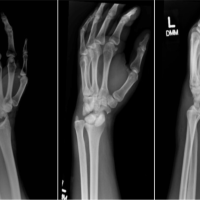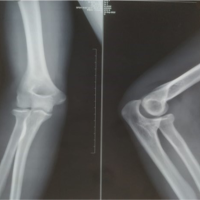[box type=”bio”] Learning Point for the Article: [/box]
Fracture-dislocations of the carpometacarpal joints are pretty uncommon injuries and high clinical suspicion with adequate plain radiographs are required to diagnose precisely CMC fracture-dislocation injuries.
Case Report | Volume 8 | Issue 3 | JOCR May – June 2018 | Page 68-70| Emre Kocazeybek, Mehmet Demirel, Ufuk Arzu, Omer Naci Ergin. DOI: 10.13107/jocr.2250-0685.1114
Authors: Emre Kocazeybek[1], Mehmet Demirel[1], Ufuk Arzu[1], Omer Naci Ergin[1]
[1]Department of Orthopedics and Traumatology, Istanbul University, Turkey, Istanbul.
Address of Correspondence:
Dr. Emre Kocazeybek,
Department of Orthopedics and Traumatology, Istanbul Medical Faculty, Istanbul University,Istanbul – 34098, Turkey, Istanbul.
E-mail: emrekczb@gmail.com
Abstract
Introduction: Fracture-dislocations of the carpometacarpal (CMC) joints are pretty uncommon injuries with an incidence of 1%. A 17-year-old male was referred due to multiple traumas following a car accident with Glasgow Coma Score of 9.
Case Report: Simultaneous metacarpophalangeal dislocation and CMC fracture-dislocation of the ring finger were present in the 4th finger (ring finger) of the right hand. Closed reduction and short arm splint in the intrinsic plus position was applied, and full range of motion was accomplished after 1 year postoperatively.
Conclusion: High clinical suspicion with adequate plain radiographs are required to diagnose precisely CMC fracture-dislocation injuries. .To the best of our knowledge, any case report similar to the nature of the present injury has yet to be reported to date, addressing CMC fracture-dislocation of the ring finger and concomitant volar MCP joint dislocation in the same finger. Therefore, we can make the argument that our case report is unique.
Keywords: Fracture-dislocation, fourth carpometacarpal joint, fourth metacarpophalangeal joint.
Introduction
Fracture-dislocations of the carpometacarpal (CMC) joints are pretty uncommon injuries as an atural consequence of the durable ligaments and magnificent architecture of the carpal bones [1]. Including CMC and metacarpophalangeal (MCP) joints, fracture-dislocations of the hand emerge from such high-energy traumas that serious injuries are most likely to be accompanied. Therefore, an intensive trauma work up is required to evaluate the whole injury [2]. The purpose of the study was to provide an evaluation of the diagnosis and treatment of an exceptional case with simultaneous dorsal dislocation of the MCP joint and fracture-dislocation of the CMC joint of the ring finger.
Case Report
A 17-year-old male was referred to the emergency department of our institute due to multiple traumas following a car accident. At the time of admission, with Glasgow Coma Score of 9,the patient was sleepy and had mismatched pupil sizes. Physical examination revealed that intense pain, gross swelling, and considerable deformity in the 4th finger (ring finger) of the right hand in addition to multiple scalp lacerations. Then, a comprehensive emergency imaging was rendered to the patient, including cranial, thorax, and abdomen. Furthermore, extensive radiographs of the right hand were obtained (Fig. 1a and b). A temporary casting was immediately employed to immobilize the fracture-dislocation. Our first decision tomanage patient’s orthopedic issue was that closed reduction and percutaneous pinning for either lesion after the neurosurgery. After a complete emergency evaluation, subdural hematoma was displayed on the cranial computed tomography (CT) in addition to massive alveolar hemorrhage on the thorax CT. With the exception of above findings, no additional pathologies were recognized. With the diagnosis of subdural hematoma, the patient was promptly taken to operating theater by neurosurgeons, to provide decompression. After the operation, due to the lung and hand pathologies, no neurosurgeons and traumatologists allowed surgical intervention for the hand fracture-dislocation. Therefore, our decision converted from surgery to non-surgicaltreatment. At the intensive care unit, closed reduction and short arm splint in the intrinsic plus position was applied with a single attempt. The reduction was confirmed through the control plain radiography.
A temporary casting was immediately employed to immobilize the fracture-dislocation. Our first decision tomanage patient’s orthopedic issue was that closed reduction and percutaneous pinning for either lesion after the neurosurgery. After a complete emergency evaluation, subdural hematoma was displayed on the cranial computed tomography (CT) in addition to massive alveolar hemorrhage on the thorax CT. With the exception of above findings, no additional pathologies were recognized. With the diagnosis of subdural hematoma, the patient was promptly taken to operating theater by neurosurgeons, to provide decompression. After the operation, due to the lung and hand pathologies, no neurosurgeons and traumatologists allowed surgical intervention for the hand fracture-dislocation. Therefore, our decision converted from surgery to non-surgicaltreatment. At the intensive care unit, closed reduction and short arm splint in the intrinsic plus position was applied with a single attempt. The reduction was confirmed through the control plain radiography. The patient was followed up with 2 daily clinic visits for 3 weeks at the intensive care unit. At the 4th week of the follow-up, the X-ray displayed a complete union in CMC fracture dislocation (Fig. 2a and b). For that reason, the splint was removed. A satisfactory range of motion (ROM) was observed at the time of the last follow-up. There was no limitation of movement, and full ROM was accomplished1 year postoperatively, DASH score was evaluated as 13.5 (Fig. 3a, b, c).
The patient was followed up with 2 daily clinic visits for 3 weeks at the intensive care unit. At the 4th week of the follow-up, the X-ray displayed a complete union in CMC fracture dislocation (Fig. 2a and b). For that reason, the splint was removed. A satisfactory range of motion (ROM) was observed at the time of the last follow-up. There was no limitation of movement, and full ROM was accomplished1 year postoperatively, DASH score was evaluated as 13.5 (Fig. 3a, b, c).
Discussion
With an incidence of 1%, CMC fracture-dislocations are particularly rare within whole hand injuries. These challenging disorders are opened to miss in the emergency departments since they frequently occur in poly traumatic patients, and to a great extent, physicians focus on other life-threatening injuries rather than CMC joint dislocations [3]. Therefore, high clinical suspicion and adequate plain radiographs of the hand are required to facilitate the diagnosis of of CMC fracture-dislocation injuries [4, 5]. Otherwise, physicians may have to confront some detrimental complications, including pain, weak grip strength, and degenerative arthritis [3]. As an example, Henderson and Arafa reported significant functional disabilities relevant to neglected CMC joint fracture-dislocations in three patients [6]. Considering the presentation of our case, a swollen hand raised suspicion of a likely hand trauma in addition to life-threatening condition, namely, CMC fracture-dislocation.Consequently, additional anteroposterior and lateral radiographs of the hand depicted simultaneous dorsal dislocation of the MCP joint and fracture-dislocation of the CMC joint of the ring finger. A number of studies illustrated that CMC fracture-dislocations tend to dislocate to dorsal side and more commonly result from high-energy traumas such as car accidents [6, 7]. Moreover, any case report similar to present injury has yet to be reported to date, addressing CMC fracture-dislocation of the ring finger and concomitant volar MCP joint dislocation in the same finger. While non-operative treatment occupies a considerable place in the management of both phalangeal and metacarpal fractures2, closed reduction and percutaneous fixation or open reduction and internal fixation, plays a pivotal role for irreducible fracture-dislocations.[8]Present studies relevant to this issue suggested that open reduction was essential for the cases of fracture-dislocation [6, 7, 9, 10]. In the light of above treatment concept, considering both concomitant cranial trauma and being reducible and stable of the present injury, we preferred the non-operative treatment. As a result, satisfactory results were accomplished both radiographically and functionally.
Conclusion
High clinical suspicion and adequate plain radiographs are required to diagnose precisely CMC fracture-dislocation injuries. The lateral radiograph should be considered since routine anteroposterior, and the oblique views are insufficient to make a precise diagnosis. Relevant physicians keep in the mind that surgical treatment is superior to non-surgical treatment; however, non-surgical treatment may be successful in the emergency settings.
Clinical Message
Conservative treatment can confer favorable outcomes for patients with MCP dislocation and CMC fracture-dislocation of the ring finger who are not able to undergo surgical treatment.
References
1. Bell T, Chinchalkar SJ, Faber K. Postoperative management of carpometacarpal joint fracture dislocation of the hand: A case report. Can J Plast Surg 2010;18:37-40.
2. Jones NF, Jupiter JB, Lalonde DH. Common fractures and dislocations of the hand. Plast Reconstr Surg 2012;130:722-6.
3. Woon CY, Chong KC, Low CO. Carpometacarpal joint dislocations of index to smalfingers: 3 cases. Injury Extra 2006;37:466-72.
4. Sharma AK, John JT. Unusual case of carpometacarpal dislocation of all the four fingers of ulnar side of hand. Med J Armed Forces India 2005;61:188-9.
5. Prokopis PM, Weiland AJ. Volar dislocation of the fourth and fifth carpometacarpal joints: A case report and review of the literature. HSS J 2008;4:138-42.
6. Henderson JJ, Arafa MA. Carpometacarpal dislocation. An easily missed diagnosis. J Bone Joint Surg Br 1987;69:212-4.
7. Kural C, Basaran SH, Ercin E, Bayrak A, Bilgili MG, Baca E. Fourth and fifth carpometacarpal fracture dislocations. Acta Orthop Traumatol Turc 2014;48:655-60.
8. Haughton D, Jordan D, Malahias M, Hindocha S, Khan W. Principles of hand fracture management. Open Orthop J 2012;6:43-53.
9. Siddiqui YS, Zahid M, Sabir AB, Kumar G. Multiple carpometacarpal fracture dislocation of the hand-an uncommon pattern of injury which is often missed: A case report with review of literature. J Clin Diagn Res 2011;5:618-20.
10. Pundkare GT, Patil AM. Carpometacarpal joint fracture dislocation of second to fifth finger. Clin Orthop Surg 2015;7:430-5.
 |
 |
 |
 |
| Dr. Emre Kocazeybek | Dr. Mehmet Demirel | Dr. Ufuk ArzuDr. Ufuk Arzu | Dr. Omer Naci Ergin |
| How to Cite This Article: Kocazeybek E, Demirel M, Arzu U, Ergin O N. Simultaneous Metacarpophalangeal Dislocation and Carpometacarpal Fracture-Dislocation of the Ring Finger: A Case Report. Journal of Orthopaedic Case Reports 2018. May- June; 8(3): 68-70. |
[Full Text HTML] [Full Text PDF] [XML]
[rate_this_page]
Dear Reader, We are very excited about New Features in JOCR. Please do let us know what you think by Clicking on the Sliding “Feedback Form” button on the <<< left of the page or sending a mail to us at editor.jocr@gmail.com



